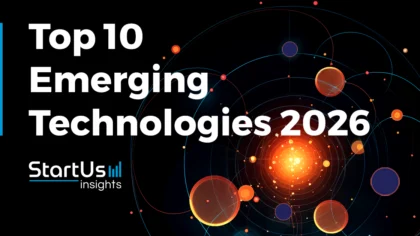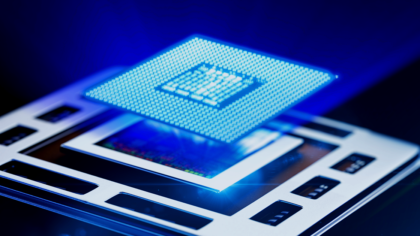Accelerate Productivity in 2025
Reignite Growth Despite the Global Slowdown
Executive Summary: What are the Top 10 IT Industry Trends in 2026?
The information technology (IT) industry is entering a new phase of innovation driven by artificial intelligence (AI) adoption, sustainability imperatives, cybersecurity demands, and immersive technologies. Top IT industry trends shaping the sector are:
- AI Agents & Gen AI: AI agents rival human performance in coding and reasoning tasks. According to GitHub, 85% of developers feel more confident and productive with AI support. The cost of achieving GPT 3.5-level performance dropped 280-fold between 2022 and 2024, increasing adoption.
- Sustainability & Green IT: Data centers consumed 415 TWh of electricity in 2024, with demand projected to reach 945 TWh by 2030, largely due to AI workloads. Governments are enforcing stricter ESG disclosures, while tech giants like Google and Microsoft target 100% renewable operations by 2025. The global green IT services market will expand to USD 45.75 billion by 2030 at a CAGR of 16%.
- Digital Trust & Cybersecurity: Cybercrime costs are expected to exceed USD 10.5 trillion annually by 2025. With 42% of organizations citing cloud-related threats as their top concern, adoption of Zero Trust and SASE frameworks is accelerating. The digital trust market is projected to reach USD 229.15 billion by 2032, while cybersecurity will grow from USD 235.50 billion in 2025 to USD 423.43 billion by 2030.
- Spatial Computing: Advances in augmented reality (AR), virtual reality (VR), Internet of Things (IoT), and AI are reshaping enterprise collaboration. Devices like Apple Vision Pro and XREAL Air 2 Ultra enable high-fidelity interaction, while NVIDIA’s Omniverse powers digital twin simulations.
- Blockchain Integration: Tokenization of real-world assets and tamper-proof ledgers are reshaping finance, supply chain, and ESG reporting. The EU’s Markets in Crypto Assets (MiCA) regulation is creating unified frameworks, while scalability and interoperability advances accelerate adoption. The blockchain market is expected to hit USD 1.43 trillion by 2030, at a CAGR of 90.1%.
- Cloud & Edge Computing: Over 90% of organizations use cloud services. Besides, 72% companies adopt cloud-based generative AI. Gartner projects 75% of enterprise data will be processed outside traditional data centers by 2025. The cloud market will reach USD 2.5 trillion by 2032, while edge computing is expected to hit USD 249.06 billion by 2030.
- IoT & 5G: IoT adoption is expanding with predictive maintenance and automation use cases, supported by rapid 5G deployment. During the 2024 Paris Olympics, a private 5G network covered six kilometers of the Seine. The IoT market will grow to USD 2.72 trillion by 2030, while the 5G market will reach USD 229.41 billion by 2032.
- Quantum Technologies: Quantum companies are set to surpass USD 1 billion in revenue in 2025, driven by improved error correction and the commercialization of quantum processing units (QPUs). More than 40 QPUs are accessible via cloud providers. The global quantum technology market will expand from USD 1.62 billion in 2025 to USD 9.65 billion by 2034.
- Robotic Process Automation (RPA) Scaling: 86% of businesses report productivity gains from RPA, with Orange saving EUR 34 million by deploying 400 bots across operations. AI-enhanced RPA now processes unstructured data and supports customer service. The global RPA market is forecasted to grow from USD 26.10 billion in 2025 to USD 483.29 billion by 2034.
- Voice-activated Technologies: With 600 million Alexa devices in use worldwide, voice adoption is accelerating across homes, cars, and enterprises. Bank of America’s AI assistant Erica surpassed 3 billion interactions by mid-2025. The global voice-activated apps market is projected to hit USD 87.5 billion by 2034.
Read on to explore each trend in depth – uncover key drivers, current market stats, cutting-edge innovations, and leading innovators shaping the future.
Frequently Asked Questions
1. What is the next big IT trend?
Agentic AI is gaining attention as a key trend in IT. These autonomous systems plan, reason, and act without or with minimal human input and function as virtual coworkers, capable of completing multi-step workflows independently.
2. What is the future of the IT industry?
According to IDC, global spending on AI-related technologies may exceed USD 749 billion by 2028. Organizations are moving beyond pilot programs and embedding AI into core business processes.
Methodology: How We Created the IT Industry Trends Report
For our trend reports, we leverage our proprietary StartUs Insights Discovery Platform, covering 7M+ global startups, 20K technologies & trends, plus 150M+ patents, news articles, and market reports.
Creating a report involves approximately 40 hours of analysis. We evaluate our own startup data and complement these insights with external research, including industry reports, news articles, and market analyses. This process enables us to identify the most impactful and recent trends in the IT industry.
For each trend, we select two exemplary startups that meet the following criteria:
- Relevance: Their product, technology, or solution aligns with the trend.
- Founding Year: Established between 2020 and 2025.
- Company Size: A maximum of 200 employees.
- Location: Specific geographic considerations.
This approach ensures our reports provide reliable, actionable insights into the IT industry innovation ecosystem while highlighting startups driving technological advancements in the industry.
Innovation Map outlines the Top 10 IT Industry Trends & 20 Promising Startups
For this in-depth research on the Top Information Technology Industry Trends & Startups, we analyzed a sample of 135 000+ global startups & scaleups. The IT Industry Innovation Map created from this data-driven research helps you improve strategic decision-making by giving you a comprehensive overview of the future trends in the IT industry & startups that impact your company.
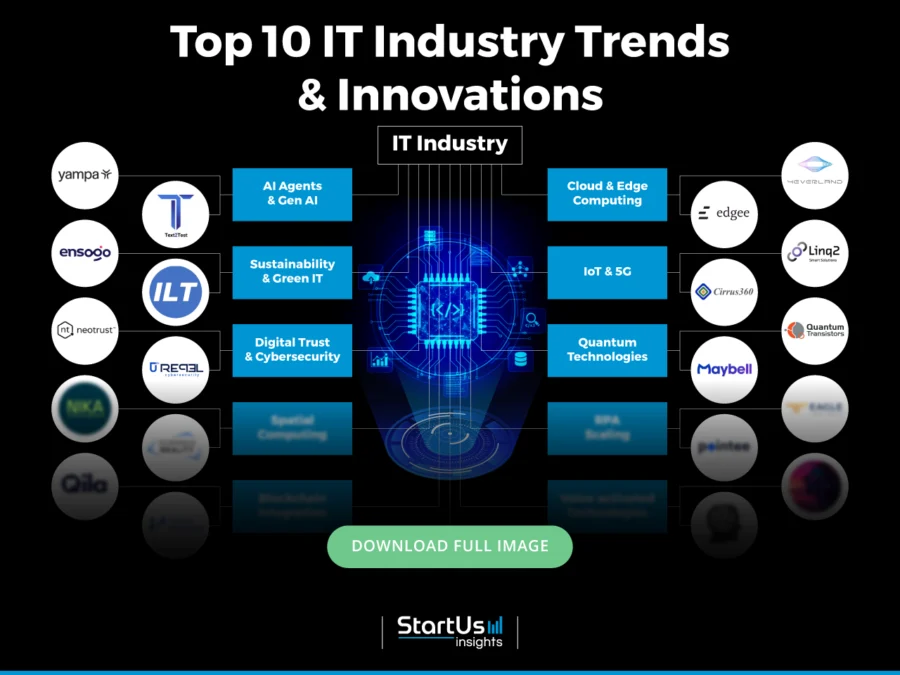
Tree Map reveals the Impact of the Top 10 IT Industry Trends
AI agents handle tasks across enterprise functions, while voice-activated tools enable hands-free interfaces in consumer and industrial settings. Cloud and edge computing support distributed architectures and enable real-time analytics.
In parallel, IoT combined with 5G expands the reach of connected ecosystems. Further, blockchain secures transactions and maintains data integrity, especially in identity management and supply chains. As digital trust becomes more critical, organizations adopt zero-trust frameworks and AI-driven threat detection.
Meanwhile, quantum technologies support faster computation and stronger encryption. Sustainability also influences IT investments. Companies are also focusing on energy-efficient hardware, circular IT practices, and carbon-aware coding. These shifts point toward IT systems that are more intelligent, secure, and environmentally conscious.

Global Startup Heat Map covers 135 000+ IT Industry Startups & Scaleups
The Global Startup Heat Map showcases the distribution of 135 000+ exemplary startups and scaleups analyzed using the StartUs Insights Discovery Platform. It highlights high startup activity in the USA and India, followed by the UK. From these, 20 promising startups are featured below, selected based on factors like founding year, location, and funding.
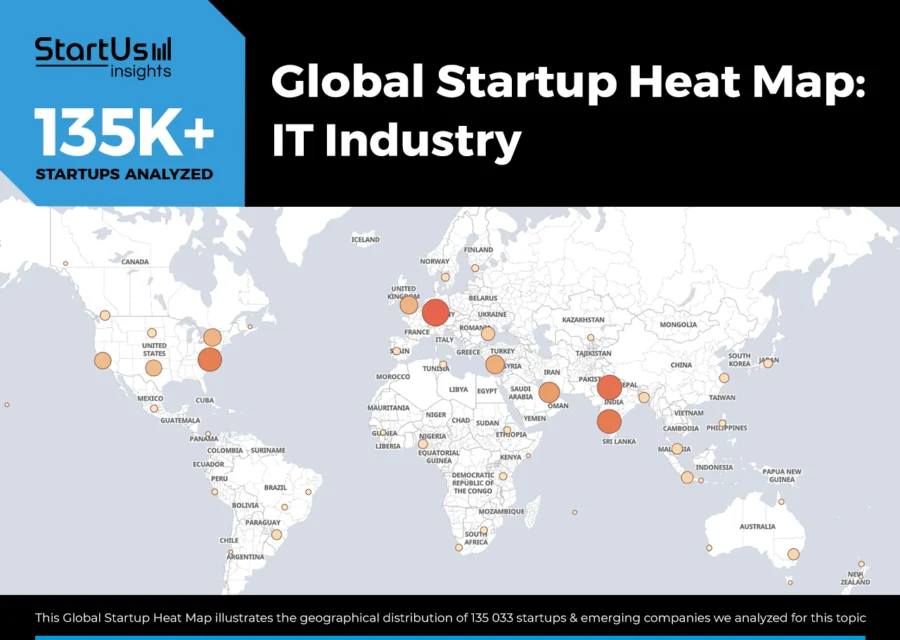
Want to Explore IT Industry Innovations & Trends?
Top 10 Emerging Trends in the IT Industry [2026]
1. AI Agents & Gen AI: 85% of Developers Feel More Productive with AI
AI agents match or exceed human performance in select tasks. For instance, recent evaluations show that language model coders solved time-bound challenges more effectively than human programmers.
These gains in coding, content generation, and reasoning have increased AI’s utility across IT workflows. As a result, organizations are building trust in AI assistants to handle complex tasks.
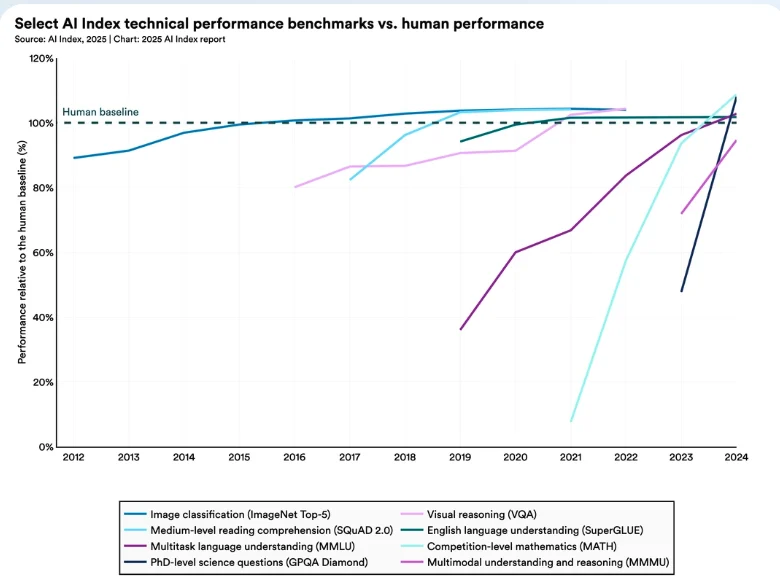
Credit: Stanford University – 2025 AI Index Report
According to the 2025 AI Index Report by Stanford University, the cost of deploying advanced AI has dropped sharply. Between late 2022 and late 2024, the cost to reach GPT 3.5-level performance fell by a factor of 280. Model optimization and improved hardware contributed to this decline.
Generative AI is widely used in large enterprises. By mid-2024, 92% of Fortune 500 companies had adopted OpenAI’s products in some form.
Rather than replacing workers, AI agents are enhancing employee performance. In 2024, 90% of business leaders reported that AI tools improved workforce skills. This is up from 80% the previous year.
These assistants allow employees to write code, create content, analyze data, and support customers. For example, GitHub Copilot generates code for developers. In surveys, 85% of developers said they felt more confident and productive with AI support.
Meta’s engineers tested an internal AI assistant that resolved coding queries. In quality assurance, automated agents generate unit tests, detect bugs, and suggest fixes, which reduces manual effort.
Autonomous AI agents are also emerging in IT operations. Experimental systems diagnose outages and provision resources without human intervention.
The private investment in AI continues to grow. In 2024, US firms invested USD 109.1 billion in AI, which is 12 times China’s USD 9.3 billion and 24 times the UK’s USD 4.5 billion.
Looking ahead, the global AI agents market may reach USD 50.31 billion by 2030, with a projected CAGR of 45.8% from 2025 to 2030.
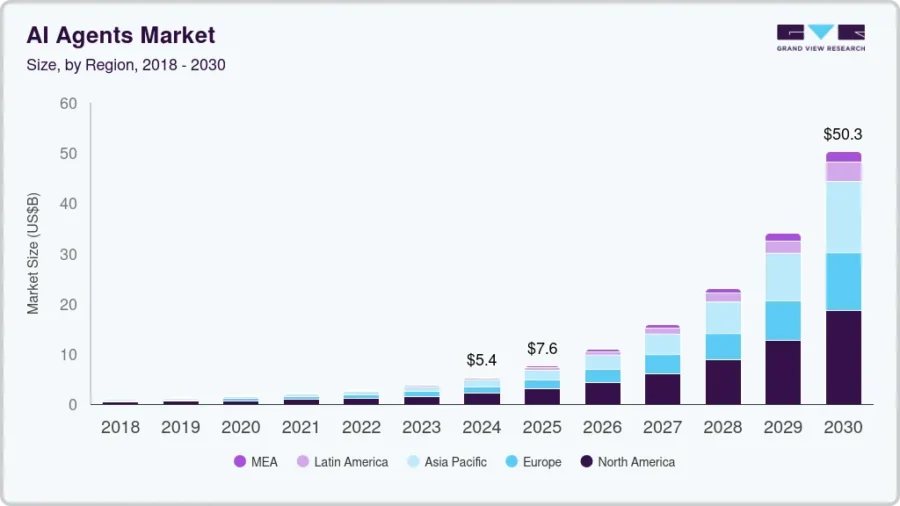
Credit: Grand View Research
Further, generative AI attracted USD 33.9 billion globally, marking an 18.7% increase from 2023. The market is also expanding. Forecasts suggest it will grow from USD 71.36 billion in 2025 to USD 890.59 billion by 2032, at a CAGR of 43.4%.
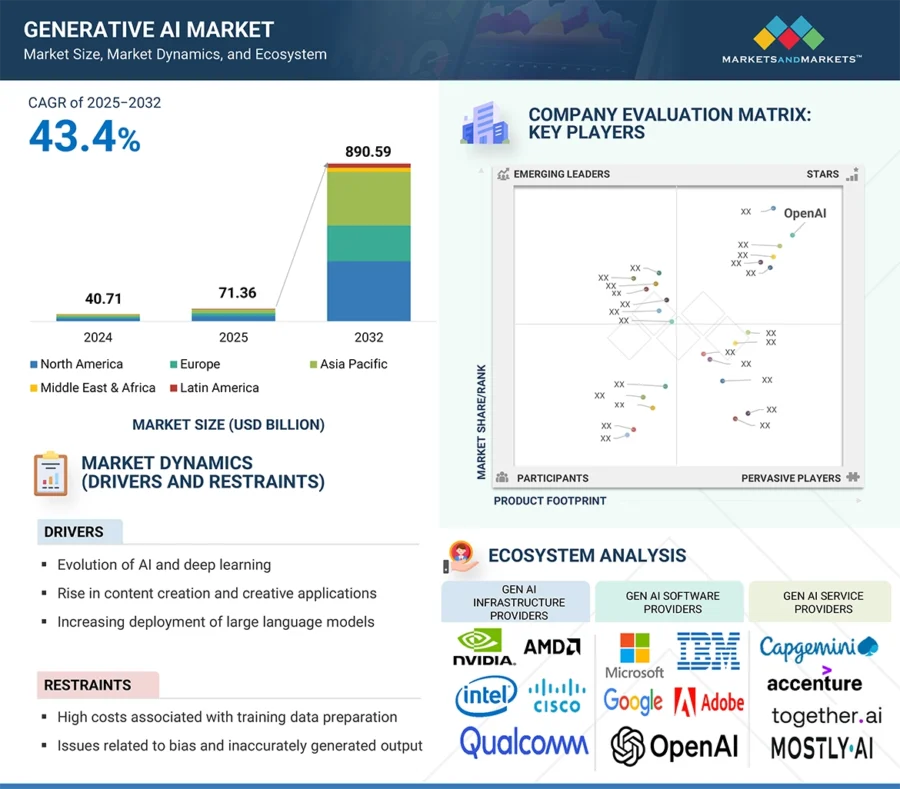
Credit: Markets and Markets
Yampa creates Autonomous AI Agents
French startup Yampa builds autonomous AI agents for customer service. The agents manage customer care across chat, voice, email, and social media. The startup’s platform utilizes natural language processing (NLP) to handle inquiries in over 90 languages and resolve issues with limited human input.
Its secure orchestration engine, Y.core, connects directly with enterprise systems for fast deployment and scalable agent operations without extra technology layers.
The startup reduces manual workloads and maintains service quality during demand spikes. Its adaptive scaling supports consistent performance across varying volumes. Additionally, the platform resolves up to 70% of inquiries independently.
In 2024, Yampa raised EUR 3 million in seed funding to expand its AI-driven customer service capabilities.
Text2Test offers Generative AI-Powered Test Automation
Turkish startup Text2Test provides an AI-powered no-code testing platform. It converts plain English or recorded videos into executable, self-healing test cases.
The platform leverages generative AI to interpret natural language and screen elements. This approach enables users to create functional and end-to-end tests without technical expertise.
It also supports reusability across web and mobile applications. Teams apply knowledge from one project to speed up testing in similar domains.
Further, Text2Test includes adaptive self-healing features. They automatically adjust tests to system changes, which reduces maintenance effort.
2. Sustainability & Green IT: Global Data Centers to Use 945 TWh by 2030
Data centers support modern IT services but consume significant energy. Global data centers used about 415 terawatt-hours of electricity last year, around 1.5% of total power consumption. By 2030, this figure may reach 945 TWh, driven largely by AI workloads.
Governments and regulators are responding with stricter sustainability requirements. For instance, the EU introduced the Corporate Sustainability Reporting Directive (CSRD) in 2024. This directive requires nearly 50 000 companies, including tech firms, to disclose detailed ESG performance.
Further, green IT often reduces operating costs. Shifting from inefficient on-premise data centers to cloud-based or modern infrastructure lowers energy use.
Several companies have announced renewable energy goals. Oracle reports that its European cloud data centers already run on 100% renewable power. It plans to extend this to all global data centers by 2025.
Google targets net-zero emissions by 2030. Its plan includes operating data centers on 24/7 carbon-free energy. Amazon Web Services (AWS) and Microsoft Azure also aim to power their operations with renewable energy by 2025.
To support these goals, companies are investing in sustainable infrastructure. Amazon committed USD 650 million to acquire a data center campus in Pennsylvania last year. This facility will draw power directly from a nearby 2.5 GW nuclear plant.
Sustainability is also shaping IT strategy and procurement. Many IT departments consider carbon footprint and resource efficiency when selecting vendors and equipment.
Hardware manufacturers are improving energy efficiency. New processors, including AI accelerators and ARM-based chips, deliver more computing power while using less energy.
The global green IT services market reflects this momentum. By 2030, it is projected to reach USD 45.75 billion, growing at a CAGR of 16% from 2025 onward.
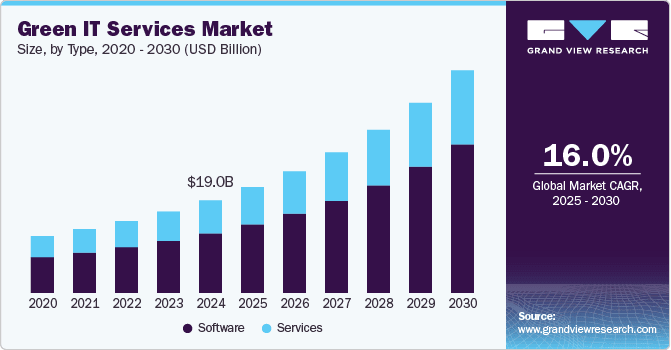
Credit: Grand View Research
Ensogo develops an ESG Platform
Canadian startup Ensogo makes an AI-native ESG platform for the IT sector. It simplifies sustainability management and improves operational performance.
The platform collects and analyzes data from internal systems, supply chains, and compliance frameworks. It then generates ESG reports aligned with global standards.
Moreover, its AI assistant, GoGo, interprets both organizational and public ESG data to deliver recommendations, track initiatives, and highlight gaps.
The platform supports energy efficiency, diversity tracking, responsible sourcing, and e-waste reduction. It also maintains strong data privacy and security protocols.
Additionally, Ensogo integrates with enterprise tools like Teams, Zoom, Slack, and OneDrive. This integration enables teams and partners to collaborate more effectively.
Scandinavian Data Center builds Circular & Secure Data Centers
Swedish startup Scandinavian Data Center makes data centers with a focus on energy efficiency, advanced cooling, and heat reuse. Its facilities redirect excess heat to district heating networks, greenhouses, and other recipients. This reduces energy waste and supports local communities.
The startup partners with Scandinavian Energy Centers to align data storage with energy optimization. They create synergies that benefit municipalities, IT providers, and energy companies working toward sustainable goals.
Its first site, ScandiDC I in Eskilstuna, transforms a former military aircraft engine facility into an AI-ready computing hub. The location offers high-density infrastructure, global fiber connectivity, and physical security and compliance.
Scandinavian Data Center provides customizable infrastructure, including private data halls and secured cabinets. These support reliability, uptime, and flexibility for a range of client needs.
Further, to improve energy resilience, its sites include battery storage systems that allow for stabilizing power grids.
3. Digital Trust & Cybersecurity: Cybercrime Costs to Exceed USD 10.5T Annually
Cybercrime continues to grow. In 2023, Microsoft reported that daily tech scam fraud traffic reached nearly 12 million incidents. This volume surpassed increases in malware and phishing.
CompTIA estimates that global cybercrime costs will exceed USD 10.5 trillion annually by 2025. This reflects a steady 10% year-over-year rise.
In April 2024, a major data breach exposed the personal information of nearly 3 billion US citizens. The data came from a single source, National Public Data, a background check and fraud prevention service.
Meanwhile, the shift to cloud and hybrid work has expanded the attack surface. In fact, 42% of organizations cite cloud-related threats as their top concern.
Digitalization and remote access have increased the number of endpoints and network edges. Cloud adoption, BYOD policies, and distributed teams require stronger security measures.
To protect data across environments, organizations are adopting new security architectures. These include secure access service edge (SASE) and zero-trust network architecture. Persistent threats, such as phishing campaigns targeting remote workers, have made cybersecurity essential to maintaining digital trust.
Companies are also using AI and machine learning (ML) to improve threat detection. Security operations centers (SOCs) rely on AI tools to automatically scan log data, detect anomalies, and neutralize threats.
Identity verification plays a key role in digital trust. Organizations must confirm user authenticity and block fraudulent access.
This need has accelerated the use of passwordless authentication. Biometrics, hardware security keys, and risk-based authentication are becoming more common. These tools adjust security requirements based on context, such as login location or device changes.
The digital trust market is growing. It is projected to reach USD 229.15 billion by 2032, up from USD 108.52 billion in 2025. This reflects a CAGR of 11.3%. The cybersecurity market is also expanding – expected to reach USD 423.43 billion by 2030 at a 12.45% CAGR.
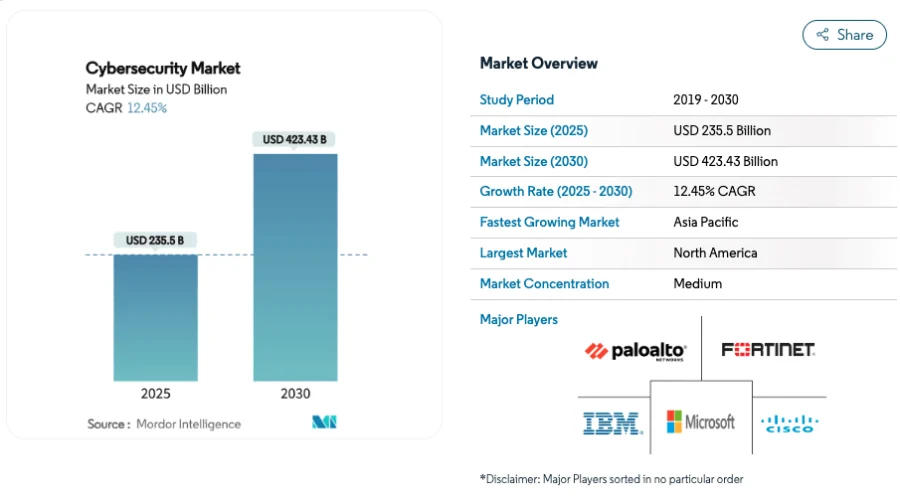
Credit: Mordor Intelligence
Neotrust provides Decentralized Digital Trust
US-based startup Neotrust builds a blockchain-powered platform for digital trust. It secures and verifies ownership of digital files, records, and assets across industries. The platform authenticates documents by linking them to verified digital identities and recording timestamps that confirm when content was created or modified.
It also certifies ownership by associating digital assets with their creators and protecting them from tampering through blockchain integrity. Moreover, the platform offers features like file verification, audit trails, multi-factor authentication (MFA), and AI-driven threat detection.
Also, the platform supports compliance with global standards like GDPR and HIPAA. It enables users to safeguard intellectual property (IP), prevent unauthorized changes, and establish clear proof of authorship.
Repel Cyber Security creates Cyber Security Solutions
UK-based startup Repel Cyber Security develops security solutions to defend organizations against digital threats. Its Ghost Technology suite provides layered protection by monitoring networks, endpoints, and cloud systems. It also integrates real-time threat detection with automated response tools.
The startup offers several specialized products. Ghost is a secure phone for untraceable communication. GhostBox is an encrypted 4G/5G router suitable for portable or fixed setups. Further, GhostMDM manages mobile devices and enforces security policies across teams.
Additionally, Repel Cyber Security’s LayerWeb services support DDoS mitigation and web application firewall protection.
4. Spatial Computing: Market to Reach USD 1.07T by 2034
Spatial computing merges 3D digital content with the physical world. It allows computers to reference and interact with real objects and spaces. The technology uses AR, VR, mixed reality (MR), IoT sensors, and AI to overlay digital data onto physical environments.
The advances in chips, sensors, and connectivity are improving device performance. Developments in 5G/6G and cloud-edge computing make AR/VR/extended reality (XR) devices lighter and more capable. For instance, Qualcomm’s XR processors and high-resolution displays enhance headset functionality.
New interaction tools, such as eye tracking and haptic gloves, are also gaining traction. Phantom’s haptic glove, showcased at CES 2024, received recognition for its realistic touch feedback.
AI plays a central role in spatial computing. It enables 3D scene understanding and powers intuitive interfaces. Companies are integrating spatial tools with AI-driven design and simulation. For example, NVIDIA’s Omniverse platform enables automotive teams to build interactive digital twins for showroom planning.
Major tech firms are deploying spatial computing in enterprise settings. Apple Vision Pro, released in 2024, is positioned for design and collaboration. It reflects growing interest in mixed reality tools for professional use.
The devices now offer higher resolution, wider fields of view, and lighter builds. XREAL’s Air 2 Ultra AR glasses, launched at CES 2024, feature 6‑DoF tracking, dual 3D sensors, and 120 Hz displays. It weighs around 80 grams and supports extended wear.
Interaction technology is also evolving. Haptic feedback delivers more tactile realism. Eye and hand tracking are becoming standard to enable control without physical controllers. Integrated AI chips allow headsets to process object recognition and gesture analysis on-device.
Investment in spatial computing is growing. Chinese AR firm Rokid raised USD 70 million in a funding round led by Hefei city’s government in 2024.
Moreover, the global spatial computing market is projected to reach USD 1.07 trillion by 2034. It is expected to grow at a CAGR of 21.7% from 2024 to 2034.

Credit: Precedence Research
NIKA enables Geospatial Computing
Singaporean startup NIKA creates NikaPlanet, a spatial computing platform for planetary-scale applications. It integrates data storage, visualization, and geospatial machine learning into a unified environment.
The platform runs on a real-time virtualizer that synchronizes data lakes, databases, virtual machines, and annotation engines. This setup allows for the elimination of fragmented workflows across multiple tools.
Through NikaMap, the platform supports large-scale raster and vector visualization. The users are able to interact with up to 15 million vector points and gigabyte-sized raster files directly in a browser.
For data processing, it offers CPU and GPU-based virtual machines with high RAM capacity. These machines support array-based machine learning and enable one-click deployment of exploratory code into production-ready geospatial functions.
Moreover, the image labeler is built for geospatial datasets and supports complex spatial annotations. In addition, Nika GAIA provides analysis tools for vegetation change, population density, and location-based planning.
ScannedReality makes a Volumetric Video Solution
German startup ScannedReality develops ScannedReality Studio, a volumetric video platform for immersive content creation. It captures spatial video using depth cameras like Orbbec Femto Bolt and Microsoft Azure Kinect. The platform then converts this data into point clouds and meshed volumetric videos that users are able to view from any angle.
Moreover, the startup’s platform includes calibration, editing, and reconstruction tools. These features allow users to refine recordings, mask static objects, and merge sequences.
ScannedReality Studio supports deployment into Unity, Unreal Engine, and web environments. It also exports files in standard 3D mesh formats for use with external tools. Its XRV codec stabilizes mesh topology, compresses video data, and enables smooth playback, even on standalone XR headsets.
5. Blockchain Integration: Market to Reach USD 1.43T by 2030
The adoption of blockchain continues to grow as organizations seek to simplify workflows and reduce costs. Studies show that investment banks could lower infrastructure expenses by up to 30% by using blockchain to modernize clearing, settlement, and other back-end operations.
Blockchain’s transparent and tamper-evident ledger enables building trust in data across organizational boundaries. These qualities support compliance efforts, especially in ESG reporting, and are driving blockchain integration in supply chain management and related areas.
Interest in tokenizing real-world assets has increased. Financial institutions are converting stocks, bonds, real estate, and fund shares into blockchain-based tokens.
In May 2024, Securitize announced USD 47 million in funding, backed by BlackRock. This move reflects growing interest in digitizing traditional financial assets.
Regulatory developments have also encouraged further investment. The EU passed the Markets in Crypto Assets (MiCA) regulation last year to create a unified framework for crypto and blockchain businesses across 27 member states.
Scalability, which was once a major challenge, has improved. New Layer-2 networks and protocol upgrades have increased throughput and lowered transaction costs.
Technologies like Cosmos’s IBC and Polygon’s cross-chain bridges connect different blockchain networks and even traditional databases.
The global blockchain technology market is projected to reach USD 1.43 trillion by 2030, growing at a CAGR of 90.1% from 2025 onward.
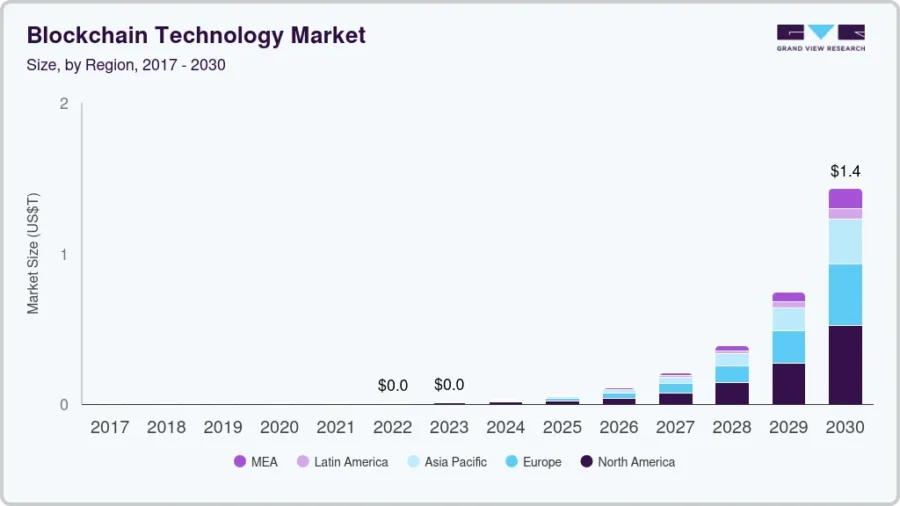
Credit: Grand View Research
Qila provides Blockchain-as-a-Service
Indian startup Qila builds a blockchain-as-a-service platform for enterprise use. It enables organizations to tokenize assets, manage digital offerings, and secure transactions using immutable records.
The platform includes ARK, a shared infrastructure for cost-efficient onboarding. It also offers ARK+, a dedicated blockchain environment that provides privacy, control, and scalability.
Moreover, Qila uses a zero-technology interface to simplify adoption. It integrates enterprise-grade cloud infrastructure with customizable settings, IPFS-based storage, and containerized deployment. These features support portability and regulatory compliance.
Additionally, the startup’s solutions apply across industries. They also improve transparency in automotive supply chains, protect medical data, diversify real estate investment, and guard luxury goods against counterfeiting.
Partisia Blockchain advances Web 3.0 Public Blockchain
Swiss startup Partisia Blockchain develops a data privacy protocol that merges multiparty computation with blockchain. It supports confidential, scalable, and interoperable digital transactions and data sharing.
The platform processes encrypted data at rest, in transit, and during use. This allows users to maintain control over their data while engaging in open digital interactions.
Moreover, the protocol uses sharding at both the network and smart contract levels to support performance. This enables applications across finance, digital identity, and data management to operate efficiently.
Partisia Blockchain also provides a secure bridge for tokens and data. This feature supports cross-chain functionality and integrates with existing digital ecosystems.

6. Cloud & Edge Computing: Over 90% of Organizations Use Cloud Services
Cloud computing has become a standard across the IT industry. More than 90% of organizations use cloud services in some capacity.
Training and running AI models, ranging from deep learning to large language models, requires significant compute power.
As AI becomes more prevalent, companies are shifting more workloads to the cloud. Surveys show that 72% of organizations already use cloud-based generative AI services. At the same time, latency-sensitive applications like autonomous systems and real-time video analytics are driving demand for edge computing.
These AI workloads require scalable, on-demand infrastructure. In response, many enterprises are expanding their cloud footprints. Hyperscale cloud providers have increased investment in GPU clusters and AI platforms to support this growth.
Further, spending on cloud initiatives continues to rise. By 2025, one-third of organizations are expected to allocate over USD 12 million annually to public cloud services.
Edge computing complements cloud by bringing compute and storage closer to where data is generated. Gartner estimates that 75% of enterprise data will be created and processed outside traditional data centers or cloud environments by 2025.
This shift supports a wide range of emerging use cases. Research highlights applications in AI/ML, AR/VR, autonomous drones, robotics, and advanced IoT, all of which benefit from reduced latency and localized processing.
The cloud computing market is projected to grow to USD 2.5 trillion by 2032, with a CAGR of 16.5% from 2025 to 2032.
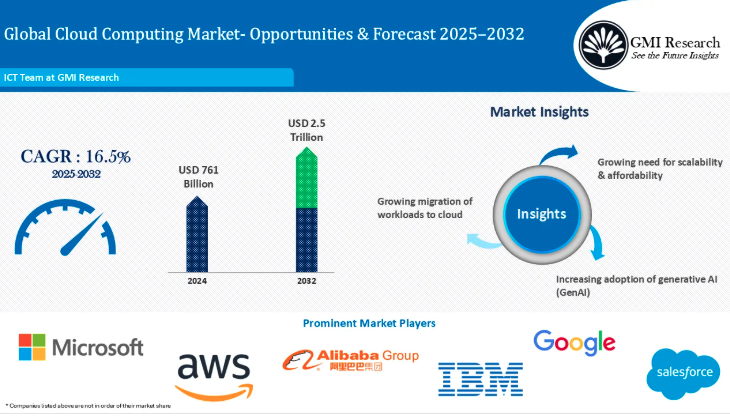
Credit: GMI Research
Meanwhile, the global edge computing market is expected to reach USD 249.06 billion by 2030, growing at a CAGR of 8.1%.
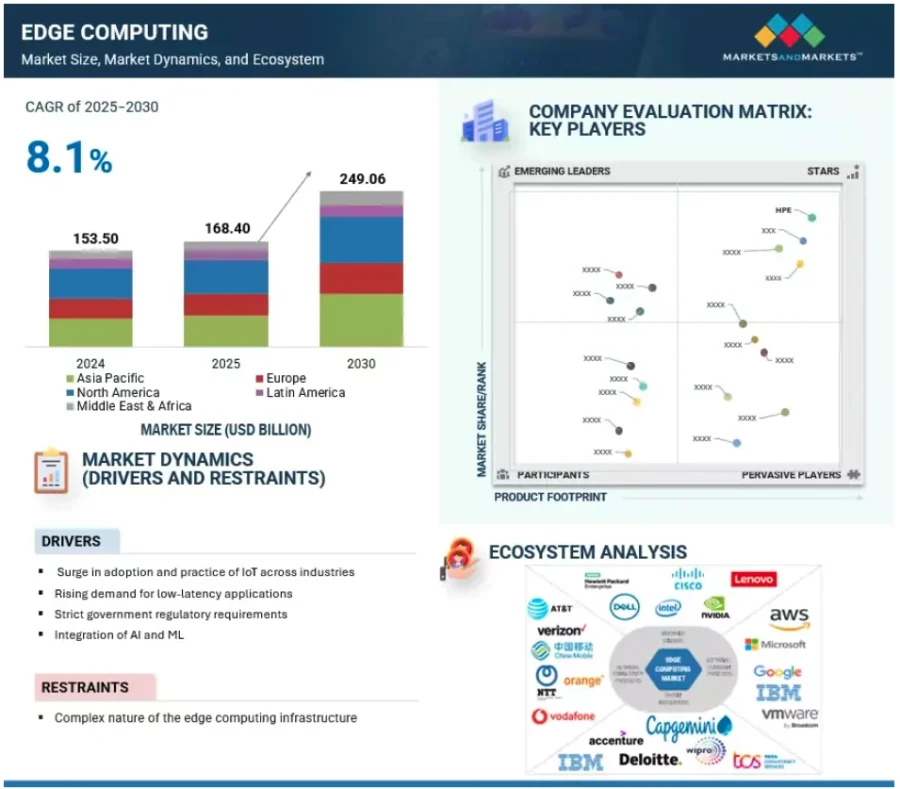
Credit: Markets and Markets
4EVERLAND builds a Decentralized Cloud Computing Platform
Australian startup 4EVERLAND creates a Web3 cloud computing platform that supports decentralized application development. It offers services for storage, hosting, gateways, RPC, and RaaS to allow teams to create and scale dApps.
The platform distributes data and compute resources across a global DePIN-powered network. This setup improves security, transparency, and resilience while reducing dependence on centralized systems.
4EVERLAND also integrates with blockchain ecosystems such as Ethereum, Polygon, Arbitrum, zkSync, and IPFS. This multi-chain support gives developers flexibility in deployment.
Further, its AI solution provides a unified interface to access and compare over 100 large language models. This feature simplifies the integration of generative AI into Web3 projects.
Edgee develops an Edge Component Platform
US-based startup Edgee makes a decentralized edge component platform for WebAssembly-based workloads. It enables developers and enterprises to build, deploy, and run applications directly at the network edge.
The platform processes data closer to users by distributing workloads across more than 100 global locations. This setup reduces latency and limits reliance on JavaScript SDKs.
Edgee also provides a registry of pre-built components for analytics, security, consent management, and personalization. The developers are able to create custom components using Rust, Go, Python, or TypeScript.
Additionally, the platform integrates with major analytics and marketing tools, including Google Analytics, Meta Pixel, and TikTok Pixel. This ensures accurate attribution, even when ad blockers or privacy settings are active.
Its architecture supports secure sandboxed execution and complies with GDPR and CCPA standards. It also enables real-time optimization of ad spend by capturing complete data visibility.
7. IoT & 5G: IoT to Reach USD 2.72T by 2030 & 5G to Hit USD 229.41B by 2032
The shift from 4G to 5G is reshaping IoT capabilities. With data rates reaching 1-20 Gbps, 5G enables real-time data transfer and streaming for connected devices.
Low latency is another key feature. 5G networks respond within milliseconds, which supports applications like autonomous vehicles, industrial automation, and remote surgery that require immediate feedback.
Some enterprises are already deploying private 5G networks. Airbus, in partnership with Ericsson, installed dedicated 5G infrastructure at several European production sites. At its Hamburg facility, 21 outdoor and 42 indoor antennas now cover 3.6 km², replacing the need for 2100 Wi-Fi access points.
5G also played a role in public events. During the 2024 Summer Olympics in Paris, organizers worked with Orange to deploy a private 5G network along a 6 km stretch of the Seine for the opening ceremony.
Market Research Future projects the 5G market will reach USD 229.41 billion by 2032, growing at a CAGR of 40.60% from 2024 to 2032.
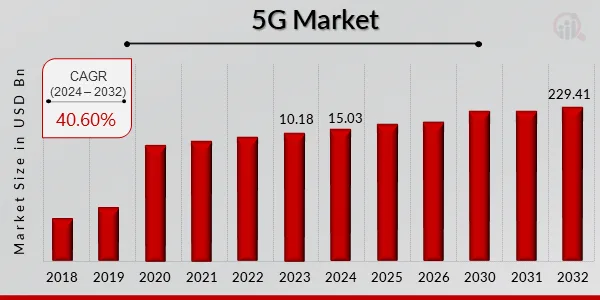
Credit: Market Research Future
Meanwhile, IoT hardware costs continue to fall. The sensors and modules are also becoming more efficient, which makes large-scale deployment more accessible for businesses.
IoT solutions aid in optimizing workflows, reducing downtime through predictive maintenance, and introducing new services.
Tech firms are expanding their IoT portfolios through acquisitions. In 2023, Semtech acquired Sierra Wireless for USD 1.2 billion, adding a major IoT module provider to its semiconductor business.
Moreover, the IoT market is growing steadily. It is expected to reach USD 2.72 trillion by 2030, up from USD 1.35 trillion in 2025, with a CAGR of 15.04%.
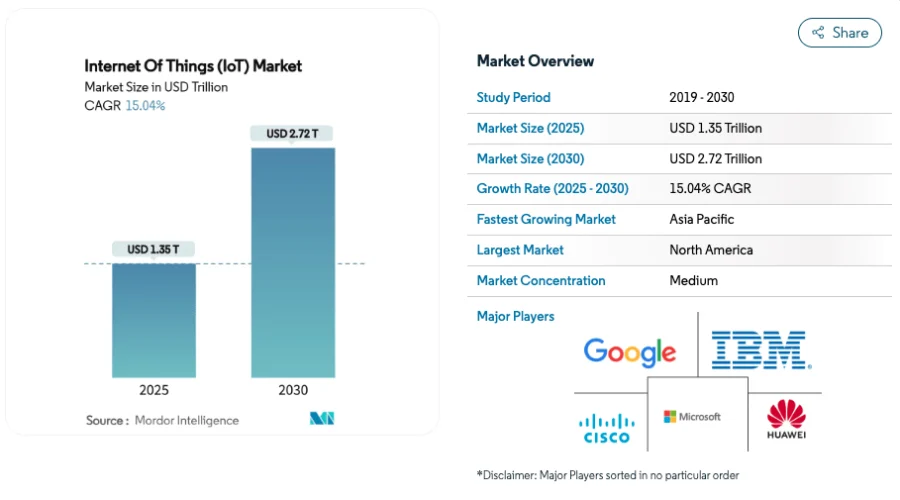
Credit: Mordor Intelligence
Linq2 creates Smart VoIP & IoT Solutions
Dutch startup Linq2 builds digital communication and IoT solutions on a unified platform. It integrates messaging, smart device connectivity, and system components to support enterprise communication and control.
The platform enables voice, SMS, fax-to-email, video calling, and chat through proprietary software. It allows users to access these services via mobile and desktop applications to manage customer interactions efficiently.
Also, Linq2 connects IoT devices to a secure web-based system. This setup enables users to control machines, extract data, and apply AI algorithms for predictive insights.
Its integration tools offer licensed components, including voice and AI chat. These features support businesses in enhancing their applications with advanced communication capabilities.
Cirrus360 offers 5G Edge as a Service
US-based startup Cirrus360 develops cloud-based solutions for data protection, business continuity, and private 5G edge connectivity. It offers backup, disaster recovery, and secure hosting by replicating data across multiple environments. These services enable safeguarding critical information and support automated workflows.
Its 5G Edge as a Service platform combines open RAN with cloud automation. This setup delivers tailored connectivity for farms, factories, and enterprise sites.
Moreover, the startup’s patented Real-time Domain Specific Language (RDSL) enables intent-driven automation. It also supports hardware-agnostic development, testing, and optimization of 5G radio access networks across multi-vendor systems.
This allows zero-touch deployments and improves explainability and security. It also aids in reducing operational costs and energy consumption.
8. Quantum Technologies: USD 1B in Revenue by 2025
The quantum technologies, including computing, communication, and sensing, are moving from lab research into commercial development.
In 2024, the focus shifted from increasing qubit counts to improving qubit stability and error rates. After years of building larger machines, the industry began prioritizing error-corrected and high-fidelity qubits. IBM, for example, introduced Condor, a 1121-qubit processor in late 2023. However, its roadmap now emphasizes reliability and error correction over raw scale.
Google’s Willow chip, with 105 qubits, showed progress in error suppression. It performed complex calculations faster than a supercomputer with lower error rates.
Startups are also advancing the quantum field. France’s Alice & Bob developed an error-correction architecture that reduces the number of physical qubits needed for a logical qubit.
Further, the hardware capabilities continued to evolve. In 2024, more than 25 organizations offered commercial quantum processing units (QPUs). Over 40 QPUs were accessible via cloud platforms, covering superconducting, ion trap, and photonic technologies.
Quantum communications also gained momentum. The anticipated arrival of Q-Day, when quantum computers could break current encryption, has accelerated work on post-quantum cryptography (PQC) and quantum key distribution.
Besides, the demand for talent is rising. In 2024, quantum-focused companies employed around 14 500 people globally. Further, the job openings grew 55% since 2021, and they reached approximately 7400 positions.
According to McKinsey, quantum computing firms generated USD 650-750 million in revenue in the last year. They are expected to surpass USD 1 billion in 2025, which marks a milestone in commercialization.
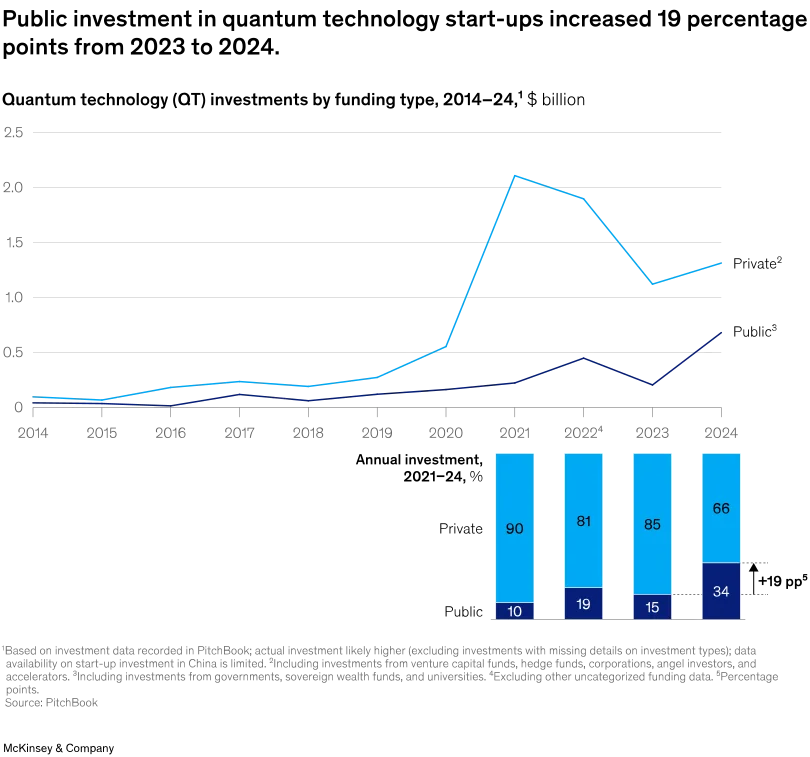
Credit: McKinsey
Looking ahead, the global quantum technology market is projected to grow from USD 1.62 billion in 2025 to USD 9.65 billion by 2034. This reflects a CAGR of 22.01% over the forecast period.

Credit: Precedence Research
Quantum Transistors make a Single-Chip Quantum Processor
Israeli startup Quantum Transistors builds a single-chip quantum processor that combines solid-state qubits, native photonics, and CMOS integration. Its design supports scalable and energy-efficient quantum computing.
The startup fabricates qubits using diamond color centers and addresses charge stability issues to enable reliable performance at scale.
Moreover, the architecture uses photonic interconnects to support qubit communication. This reduces interference and allows distributed entanglement. It also enables expansion beyond a single chip through fiber-based connections.
Quantum Transistors also integrates the control plane directly on-chip using CMOS. It removes a key scalability barrier and simplifies system complexity.
Maybell Quantum creates Quantum Infrastructure Solutions
US-based startup Maybell Quantum develops cryogenic infrastructure and quantum hardware to support scalable quantum computing. It designs dilution refrigerators, The Fridge and The Big Fridge, that reach base temperatures below 10 mK. These systems offer increased qubit capacity and reduced physical footprint compared to traditional models.
The refrigerators also feature maintenance-free micro roots blowers, welded joints to prevent leaks, and self-cleaning helium traps for extended reliability. They also provide large sample volumes and fast cooldown times. Front-loading wiring inserts allow users to prepare assemblies outside the unit and install them with minimal disruption.
To complement its refrigeration systems, Maybell Quantum offers Flexlines, high-density RF ribbon cables that lower thermal load and vibration while preserving performance. Moreover, the additional wiring and fiber optic options support flexible integration across setups.
9. RPA Scaling: 86% of Businesses Report Productivity Gains
Companies continue to face pressure to reduce costs and improve return on investment. RPA addresses these goals by lowering labor and error-related expenses. According to SMA’s 2024 State of Automation in Financial Services Report, 69% of leaders reported annual savings of USD 100 000 or more from automation. In contrast, only 41% of slower adopters achieved similar results.
Organizations are turning to RPA to manage skilled labor shortages and reduce repetitive tasks. Automating routine work with bots increases productivity and allows employees to focus on higher-value activities.
About 89% of employees report higher job satisfaction when repetitive tasks are automated. Additionally, 86% of businesses have seen productivity gains from RPA adoption.
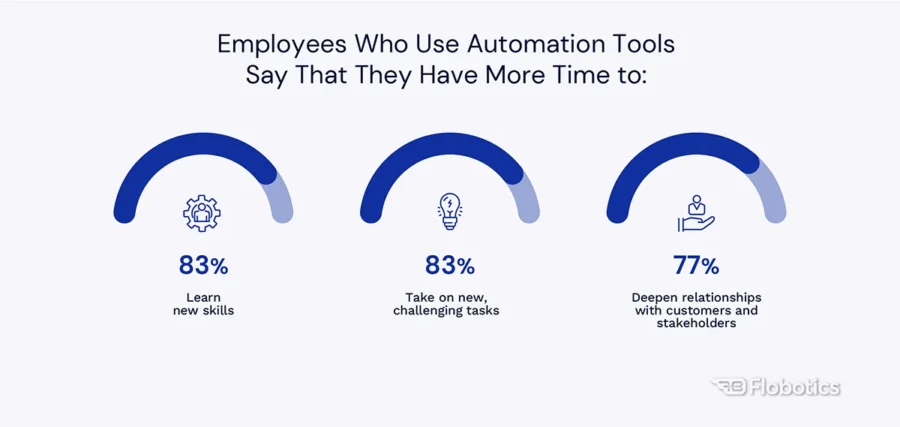
Credit: Flobotics
AI integration is expanding the scope of RPA. While traditional RPA handled rule-based tasks, combining it with AI and machine learning enables bots to process unstructured data and make complex decisions. Technologies like computer vision and natural language processing allow bots to interpret documents and emails.
For example, UPS deployed a generative AI system to manage customer emails to reduce handling time by 50% in a high-volume contact center.
In Europe, telecom operator Orange launched an internal robot factory to scale automation. Over two years, it deployed more than 400 RPA bots across network operations and customer service. This initiative saved over EUR 34 million in operating costs and trained 250 employees in RPA skills.
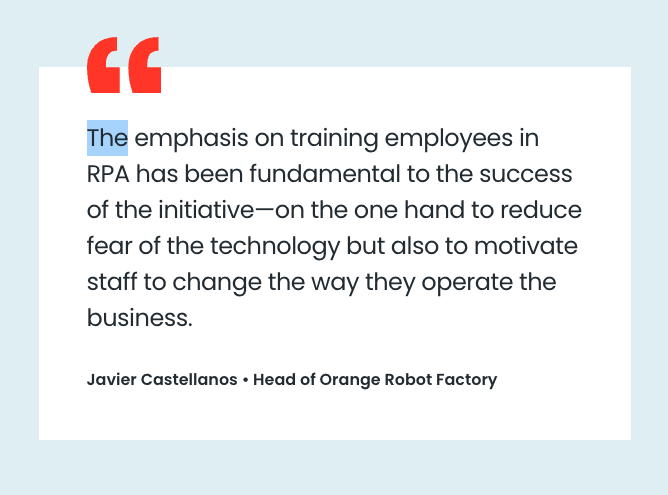
Credit: UiPath
Moreover, the global RPA market is expected to grow from USD 26.10 billion in 2025 to USD 483.29 billion by 2034. This reflects a CAGR of 38.3% over the forecast period.
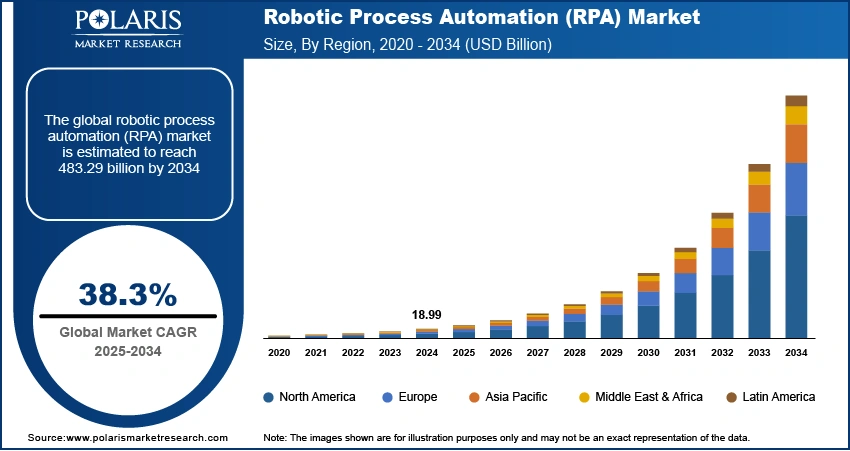
Credit: Polaris Market Research
Eagle Insight builds an RPA Analytics Platform
Irish startup Eagle Insight develops a cloud-based analytics platform for RPA. It connects people and software robots for organizations to manage and improve automation programs.
The platform integrates with tools like UiPath and Blue Prism to extract operational data and convert it into dashboards. These dashboards provide real-time insights into bot usage, productivity, and exception handling.
Moreover, the platform includes automated business case generation, process prioritization, and per-process analytics to support decision-making. These features enable evaluation of key metrics like ROI, handling time, and transaction volume.
Eagle Insight also offers department-specific insights, Kanban boards for development tracking, and ticket management tools. These additions improve collaboration between support and operations teams.
Pointee enables Dynamic RPA Orchestration
Czech Republic-based startup Pointee offers an AI-powered platform for RPA management and optimization. It combines predictive analytics, dynamic orchestration, and real-time monitoring within a single system.
Also, the platform collects and analyzes bot data, identifies anomalies, and detects root causes of failures. This reduces downtime and improves process speed.
The platform automates orchestration tasks, cuts manual scheduling, supports SLA compliance, and improves license and infrastructure use.
Moreover, the platform includes automated reporting tools to support performance tracking. These offer customizable dashboards and internal billing features that give stakeholders clear visibility into automation results and ROI.
In addition, it provides governance-driven orchestration and proactive incident detection. These capabilities enable organizations to scale automation, reduce operational costs, and increase the long-term value of their digital workforce.
10. Voice-activated Technologies: Market to Reach USD 87.5B by 2034
As of early 2025, Amazon reports 600 million Alexa-powered devices in use worldwide. This reflects growing consumer interest in voice interfaces for everyday tasks.
Speech recognition now approaches human-level accuracy. At the same time, generative AI is enhancing voice technology. Large language models (LLMs) improve contextual understanding and natural language generation in voice assistants.
Consumers prefer voice interfaces for their speed and hands-free convenience. Many use voice commands to quickly complete tasks rather than typing. Smart-speaker owners often rely on voice control while cooking, driving, or multitasking.
The rise of IoT and smart devices has expanded voice interface adoption. Most smartphones include built-in voice assistants, and smart speakers and displays are common in homes. Voice controls have also reached cars, TVs, appliances, wearables, and enterprise tools.
Further, language support continues to improve. Modern voice platforms handle dozens of languages and dialects, which broadens their global reach.
Advances in AI-generated speech are opening new use cases. Voice generators produce speech that closely resembles human voices, including emotional tone and regional accents.
Voice technology is also gaining traction in enterprise and public services. Companies are embedding voice UIs into customer support, productivity tools, and digital products. For example, Bank of America’s AI assistant Erica surpassed 3 billion client interactions by mid-2025, averaging 58 million per month.
Moreover, investor interest in voice tech continues to grow. The venture funding for voice AI startups rose from USD 315 million in 2022 to USD 2.1 billion in 2024.
Besides, the global voice-activated apps market is projected to reach USD 87.5 billion by 2034. It is expected to grow at a compound annual rate of 30.8% from 2025 to 2034.
Credit: market.us
jo provides a Voice-activated Digital Assistant
US-based startup jo builds a proactive AI assistant to support everyday digital tasks. It combines voice interaction, fast summarization, and intelligent scheduling to improve workflow efficiency.
The assistant integrates with platforms like Google, Amazon, Facebook Marketplace, and Gmail. It performs quick searches, summarizes content, and offers contextual support within the user’s existing tools.
Moreover, jo captures user-provided information and syncs with both personal and work calendars. It then suggests availability to simplify scheduling and reduce manual coordination.
Further, it offers features such as hover-based page summaries, voice-activated commands, and adaptive personalization based on user behavior.
Voiceflow offers Voice AI Reception & Forms
UK-based startup Voiceflow develops AI-powered conversational platforms to automate customer engagement and call center operations. It supports voice, chat, and multimodal interfaces to simplify communication across channels.
The startup offers the AI Reception platform, which manages inbound calls around the clock. It integrates with Office 365 directories, connects to CRM systems, and enables warm handovers so employees are able to accept, transfer, or record messages with minimal friction.
Voice Forms automates form completion and workflow execution. This allows call centers to deflect routine inquiries, lower cost per call, and manage demand spikes more effectively.
Moreover, Voiceflow provides AI Case Bots that combine concierge services with automated workflows. These bots operate across platforms such as TMFORUM Service Catalog and ServiceNow, extending automation to more complex business processes.
Additionally, the platform supports cloud-hosted call centers on AWS Connect. The features include skill-based routing, omnichannel integration, call recording, real-time analytics, and sentiment analysis.
Further, Voiceflow raised USD 15 million in a funding round led by VC firm OpenView.
Discover all IT Industry Trends, Technologies & Startups
The IT industry continues to evolve through emerging technologies. Neuro-symbolic AI, programmable quantum networks, and AI governance frameworks are becoming key areas of focus. At the same time, biocomputing, zero-energy edge devices, and AI-powered sustainability dashboards are gaining momentum.
These innovations are shaping the next phase of IT. They promote faster operations, support energy-efficient infrastructure, and align with growing demands for trust, performance, and scalability.
The IT Industry Trends & Startups outlined in this report only scratch the surface of trends that we identified during our data-driven innovation & startup scouting process. Identifying new opportunities & emerging technologies to implement into your business goes a long way in gaining a competitive advantage.
![Dive into the Top 10 IT Industry Trends & Innovations [2026]](https://www.startus-insights.com/wp-content/uploads/2025/08/IT-Industry-Trends-SharedImg-StartUs-Insights-noresize-420x236.webp)


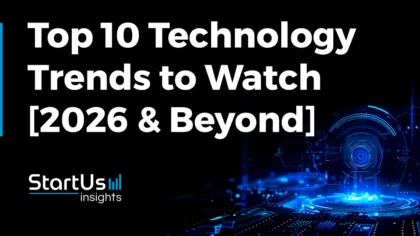
![Discover the Top 10 Industrial Machinery Trends & Innovations [2026]](https://www.startus-insights.com/wp-content/uploads/2025/08/Industrial-Machinery-Trends-SharedImg-StartUs-Insights-noresize-420x236.webp)
